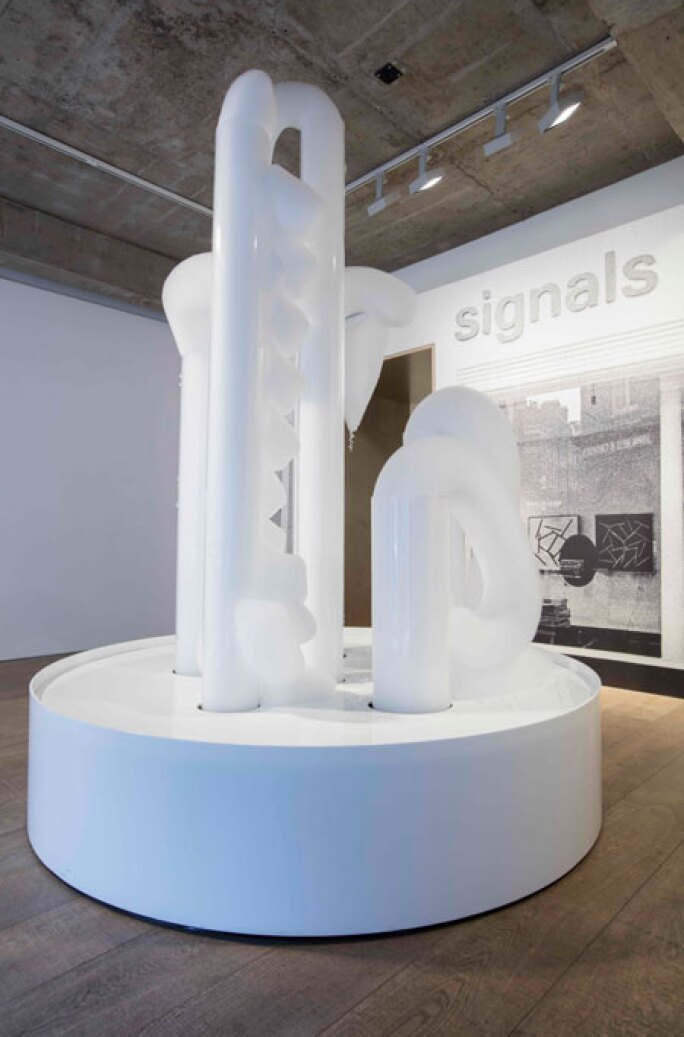For the avant-garde art scene of 1960s London, photographer Clay Perry was a key figure, documenting many of the most innovative international artists of the period. Perry worked with artists such as Yoko Ono, David Medalla, Robert Rauschenberg, Sérgio de Camargo, Gustav Metzger, Jesús Rafael Soto, Mark Boyle, Mira Schendel, Liliane Lijn and Takis. In the summer of 1964, he became ‘house photographer’ for Signals London, producing iconic images for the Signals Newsbulletin, the publication that provided a forum for artists, writers and poets involved in experimental art and was ‘dedicated to the adventures of the modern spirit.’
Perry became involved with Signals London when it began operating in Paul Keeler’s flat in Cornwall Gardens, South Kensington, under its initial title, The Centre for Advanced Creative Study. The first exhibition Perry visited and documented in Keeler’s first-floor flat included works by the Latin American artists Soto, Camargo and Cruz-Diez; by Greek sculptor, Takis; and by an Italian artist, Marcello Salvadori, who Perry recalls ‘making illuminated moving panels of Polaroid material’. Keeler wanted Perry to photograph these works for the first newsbulletin of this organization (soon to be renamed Signals) that he was planning with his co-founders: the Filipino artist David Medalla, art critic Guy Brett, and artists Marcello Salvadori and Gustav Metzger. Perry describes Medalla as ‘the driving force at Signals’, with ‘his extraordinary creative energy and knowledge of the art world” combining with “Paul’s entrepreneurial skills.’
In the midst of this activity at the flat in Cornwall Gardens, Medalla was developing his series of Bubble Machines (Auto Creative Sculptures). These consisted of a series of vertical white boxes, each containing a small electric motor in a tub which Perry recalls being ‘charged with Matey, a child’s liquid bubble bath, to produce quite extraordinary bubble sculptures’. The machines were erected on the balcony which exposed the sculptures to different weather conditions: ‘in a high wind the bubbles would take off and become flying sculptures!’
Medalla and Keeler wanted these bubbles to be documented in different conditions and so Perry became a regular visitor to Cornwall Gardens: ‘I was living in the Portobello Road at that time and would get urgent phone calls, asking me to jump in a cab and come immediately as the bubbles were behaving in a particular way. We photographed the machines over a period of several weeks and built up a portfolio of photographs that appeared in the second edition of SIGNALS magazine.’
These embryonic Bubble Machines evolved into the Cloud Canyons: Guy Brett described ‘The foam… emerging and forming according to its own energies, interacting with gravity, air currents, atmospheric pressure, and the shape of the containers ... the analogy with clouds was no exaggeration.’ After two pilot exhibitions at Keeler’s flat, Signals moved to Wigmore Street, becoming ‘a major showroom of the international avant-garde.’
The gallery’s regular artists lent a hand in decorating floors of the building, previously the showrooms for Keeler’s father’s optics business. SIGNALS LONDON was inaugurated with an exhibition of ‘magnetic sculpture’ by the Greek artist Takis, and in the months before, Perry spent time in Paris where Takis had his studio, taking photographs of him and his works, Magnetic Sculpture and Ballet Magnetique’. Perry also photographed Soto, Camargo and Cruz Diez who were all living and working in Paris at that time.
In 1966, Keeler commissioned Perry to attend the Venice Biennale to film the works of Camargo, Soto and Julio le Parc. Soon afterwards, Signals came to what Perry remembers as an abrupt end. However, looking back, Perry feels that Signals was ‘very much part of the optimism of the time and something I am pleased to have been part of.’
CLICK HERE to view the Signals exhibition at S2.
Article © Jane England








